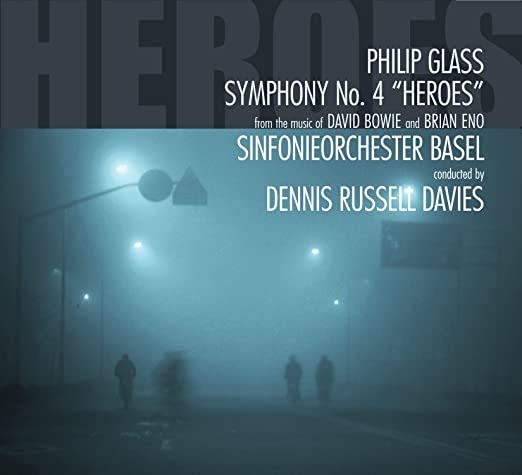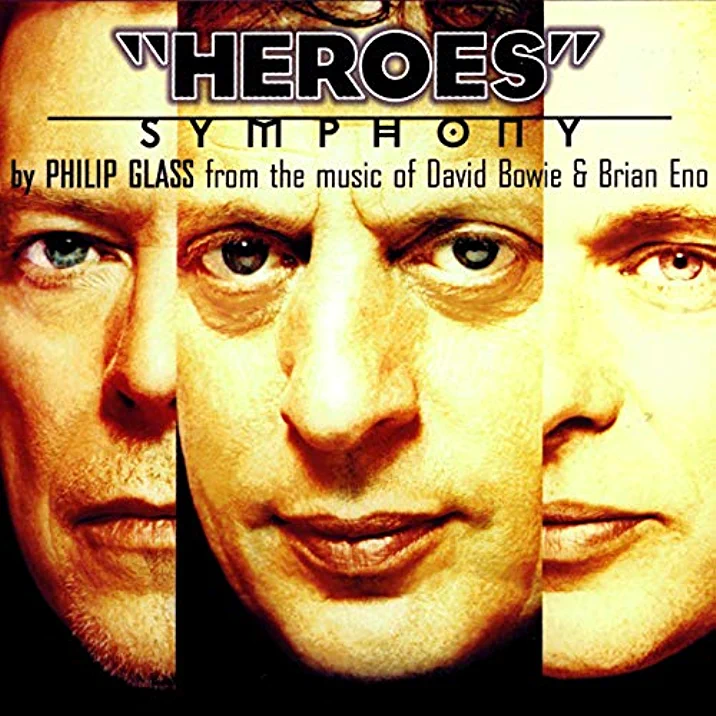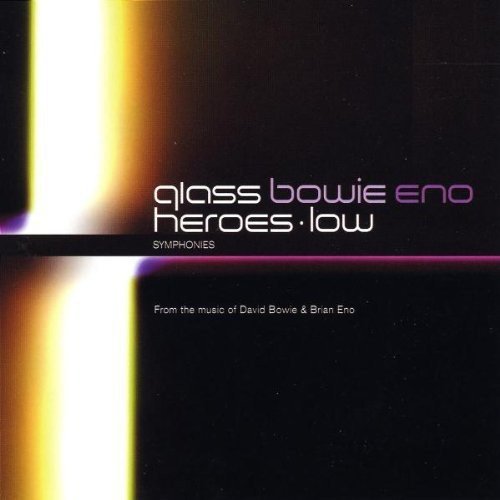Symphony No. 4 “Heroes” (2014)
Catalog
Orange Mountain Music OMM0096
UPC 801837009620
Tracks
1. Movement I Heroes 9:28
2. Movement II Abdulmajid 9:24
3. Movement III Sense of Doubt 7:29
4. Movement IV Sons of the Silent Age 8:37
5. Movement V Neukoln 7:58
6. Movement VI V2 Schneider 7:17
Credits
Recorded at Musiksaal, Stadt-Casino September 10 & 12, 2012
Andreas Werner – Recording Engineer
Jacob Haendel – Recording Engineer
Franziskus Theurillat – Director
Yannick Studer – Production
A & R and Special Projects Director: Richard Guerin
Digipack cover photo: Roy Cheung
Booklet cover photo: Andreas Hidbar
Design: Don Christensen
Philip Glass’s music is published by Dunvagen Music Publishers, Inc.
Executive Producers for Orange Mountain Music: Philip Glass, Kurt Munkacsi and Don Christensen
Notes
“Heroes” Symphony, like The Low Symphony of several years ago is based on the recording of the same name made by David Bowie and Brian Eno in the late 70s. During that period David and Brian were attempting to extend the normal definition of pop and rock and roll. In a series of innovative recordings in which influences of world music, experimental ‘avant- garde’ were used, they were re-defining the language of music in ways which can be heard even today.
Almost twenty years later, I have gone back to their original material, using it as a point of departure and inspiration, much as composers of the past have based their work on their contemporaries. Using themes from Heroes I have made a new composition which hopefully will reintroduce this music to today’s listeners.
I mentioned the new work I was doing to Twyla Tharp, the American choreographer with whom I had worked on In the Upper Room, a dance work for her company. She suggested I think of Heroes as a ballet score for her new dance company. We suggested this to David, who immediately shared Twyla’s enthusiasm for the Idea. Accordingly, I set Heroes as a six movement work, each movement based on a theme from Heroes, with an overall dramatic structure that would be suitable for dance. The result is a symphonic ballet – a transformation of the original themes combined with new material of my own and presented in a new dramatic form.
– Philip Glass 1996
Listen and Buy
Related
COMPOSITIONS:
Symphony No. 4
Symphony No. 4 “Heroes” (1997)
Catalog
Point Music 454-388-2
1997
Tracks
Dennis Russell Davies, conductor
1 Heroes 5:53
2 Abdulmajid 8:53
3 Sense of Doubt 7:20
4 Sons of the Silent Age 8:18
5 Neuköln 6:41
6 V2 Schneider 6:48
Credits
Composed By – Philip Glass
From the Music of David Bowie and Brian Eno
Conductor – Dennis Russell Davies
Associate Conductor – Michael Riesman
Orchestra – American Composers Orchestra
Producer – Kurt Munkacsi, Michael Riesman
Recorded at Looking Glass Studios
Notes
“Heroes,” like the “Low” Symphony of several years ago, is based on the work of David Bowie and Eno. In a series of innovative recordings made in the late 70’s, David and Brian combined influences from world music, experimental avant-garde, and rock & roll and thereby redefined the future of popular music. The continuing influence of these works has secured their stature as part of the new “classics” of our time.
Just as composers of the past have turned to music of their time to fashion new works, the work of Bowie and Eno became an inspiration and point of departure of for a series of symphonies of my own.
As I have been involved with the world of dance for many years I naturally mentioned the “Heroes” Symphony to the American choreographer Twyla Tharp. Straight away she wanted “Heroes” for her new dance company, and soon after, we met with David. He immediately shared Twyla’s enthusiasm and I found myself writing a symphonic score shortly to become a ballet.
– Philip Glass
Listen and Buy
Related
COMPOSITIONS:
Symphony No. 4
Symphony No. 4 “Heroes” (2003)
Catalog
Universal
Tracks
CD ONE: HEROES
1 Heroes 5:53
2 Abdulmajid 8:53
3 Sense of Doubt 7:20
4 Sons of the Silent Age 8:18
5 Neuköln 6:41
6 V2 Schneider 6:48
CD TWO: LOW
1 I “Subterraneans” 15:07
2 II “Some Are” 11:17
3 III “Warszawa” 15:57
Credits
Music by Philip Glass
From the Music of David Bowie & Brian Eno
The American Composers Orchestra — Dennis Russell Davies, principal conductor
The Brooklyn Philharmonic Orchestra — Dennis Russell Davies, principal conductor
Notes
This two CD collection is a coupling of two of Philip Glass’ most famous orchestral compositions, both based on the music of David Bowie & Brian Eno. This compilation consists of previously released material.
Listen and Buy
Related
COMPOSITIONS:
Symphony No. 4
Symphony No. 4 “Heroes” (2007)
Catalog
Naxos 8.559325
2006
Tracks
The Light
1. The Light 23:43
Symphony No. 4, “Heroes”
1. I. Heroes 7:24
2. II. Abdulmajid 9:19
3. III. Sense of Doubt 7:57
4. IV. Sons of the Silent Age 7:36
5. V. Neukoln 6:48
6. VI. V2 Schneider 7:22
Credits
Music Composed by Philip Glass
Performed by Bournemouth Symphony Orchestra
Marin Alsop, Conductor
Notes
Although he remains best known for the works written for his own ensemble (above all, Music in Twelve Parts of 1974) and works for the stage, not least the trilogy of operas written in collaboration with Robert Wilson, Einstein on the Beach (1975), Satyagraha (1980) and Akhnaten (1984), orchestral music has been at the forefront of activities for Philip Glass for much of the last two decades. Already in 1987 his Violin Concerto [Naxos 8.554568] gave notice of a new interest in the forms and procedures of the Classical and Romantic eras, an interest that has led to eight symphonies and a number of independent orchestral works.
The symphonies evince a wide range of approaches to the genre. Only two (Nos. 2 and 8) are full-length abstract designs. No. 3 is a compact work for string orchestra [Naxos 8.559202, Symphonies Nos. 2 and 3], No. 6 a setting of Allan Ginsberg’s Plutonium Ode, while Nos. 5 and 7 are large-scale choral works, symphonic in designation only. Nos. 1 and 4, though multi-movement orchestral works, are distinguished by having drawn their inspiration from decidedly non-Classical sources.
In 1993, Glass completed his Low Symphony, a work taking inspiration from the Low album released by David Bowie in 1977. Among the most prolific and influential of rock musicians, Bowie had established an international reputation with such albums as The Rise and Fall of Ziggy Stardust and the Spiders from Mars (1972), Aladdin Sane (1973) and Station to Station (1976), enhancing the individuality of his music with often elaborate stage-shows where he appeared as the character central to each album. After an exhausting 1976 world tour, Bowie decided on a radical change of approach to making music. Relocating to West Berlin, in the then divided city, he began a collaboration with Brian Eno that changed rock music as decisively as any other development in what was a radical and innovative era for the medium.
A former member of rock band Roxy Music, Eno had gone to make a series of solo albums, but was then about to devote himself to the possibilities of synthesizer technology in what became known as ‘ambient composition’: abstract and often understated electronic music intended to create an environment for listening rather than being the focus of attention as such. Beginning with Low, an album of powerful songs and evocative instrumental pieces, he and Bowie went on to create two further albums in Heroes (1977) and Lodger (1979), each drawing inspiration from the segregated city, with its tangible resonance of the ‘cold war’ era, that was then Berlin.
Having selected several tracks from Low to create his Low Symphony, Glass did the same for Heroes in his Heroes Symphony of 1996. The immediate incentive came from American choreographer Twyla Tharp, keen for a work for her new dance company. Glass took six of the ten tracks from Heroes, reworking them so that they become independent pieces that between them build into a self-sufficient musical work.
Horns sounding out over a tramping rhythm in the bass usher in Heroes, which gradually increases in harmonic and rhythmic activity; elements of the song being distributed across the orchestral texture so that the Bowie/Eno original informs the music at all levels without ever dominating it. The initial horns and bass motif, now with a rejoinder from the strings, presently returns to round off the piece.
Against castanets and pulsating strings, Abdulmajid (a bonus track on the 1991 re-release of Heroes by Rykodisc) unfolds a wistful, Arabic-sounding theme complemented by delicate tags from celesta and percussion. This takes on a notably more ominous quality as the textures gradually thicken out, but the emotional feel of the music remains consistent through to its understated close on flute and pizzicato basses.
Sense of Doubt opens with a stark descending motif for brass against a starkly-held chord on upper strings, contrasted with rising figures for tuned percussion. This suddenly breaks off to leave solo woodwind and strings musing over a rhythmic bass, the texture becoming more animated in the course of new instrumental entries. The initial motif returns, and plangent woodwind chords effect a poignant close.
Hesitant initial gestures prepare for the wistful theme of Sons of the Silent Age, shared between wind instruments over an undulating string backdrop. The accompanying rhythmic pattern migrates across all the strings, bringing a crescendo towards the heightened return of the opening gestures, after which, the main theme returns much as before to take the piece through to its ruminative conclusion.
A carillon-like gesture on tuned percussion opens Neuköln, alternating with angular gestures from strings. Rhythmic activity at length picks up, and strings then unfold a tensely expressive theme that gradually winds down, only for the initial motifs to resume their alternating dialogue. The piece presently focusses on a cadential phrase in the lower strings, which itself brings about the questioning close.
V2 Schneider opens with animated rhythmic motion in brass and percussion, strings and woodwind excitedly trading motifs as the music gains in incisiveness. The rhythmic motion solidifies into a pulsating ostinato, over which the activity gains both in textural and dynamic intensity, building to a peak of activity which is topped by the forceful closing chord, so rounding off the whole work to decisive effect.
Written to a commission from Case Western Reserve University in 1987, The Light has its inspiration in a very different source: the Michelson-Morley experiment confirming the uniform speed of light, so paving the way for its theoretical explanation in Einstein’s theory of Relativity two decades on. Seeking a musical corollary, Glass’s piece has an expressive introduction followed by an energetic main movement: a ‘before’ and ‘after’ mirroring the onset of modern scientific research.
The piece opens with a gently undulating motif in strings, which gradually extends over an intent rhythmic backing from lower brass. Gentle woodwind patterns emerge as the music gains in momentum, further such patterns on strings and brass entering before the tempo picks up markedly. Brass and timpani confirm this increase in activity, as do skirling gestures from woodwind and percussion. A sense of anticipation is central to the music’s progress, with motifs expanding and contracting accordingly. At length the accumulated activity brings a transformed version of the strings’ initial motif. Textures thin out to leave the motif over a pulsating motion in the bass, the music now losing impetus as tension subsides and fragments of the motif sound out over an accompaniment whose sudden cessation ends the piece.
Richard Whitehouse
Listen and Buy
Related
COMPOSITIONS:
Symphony No. 4




